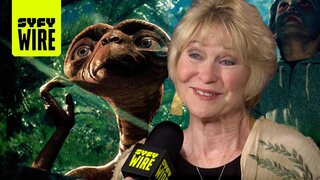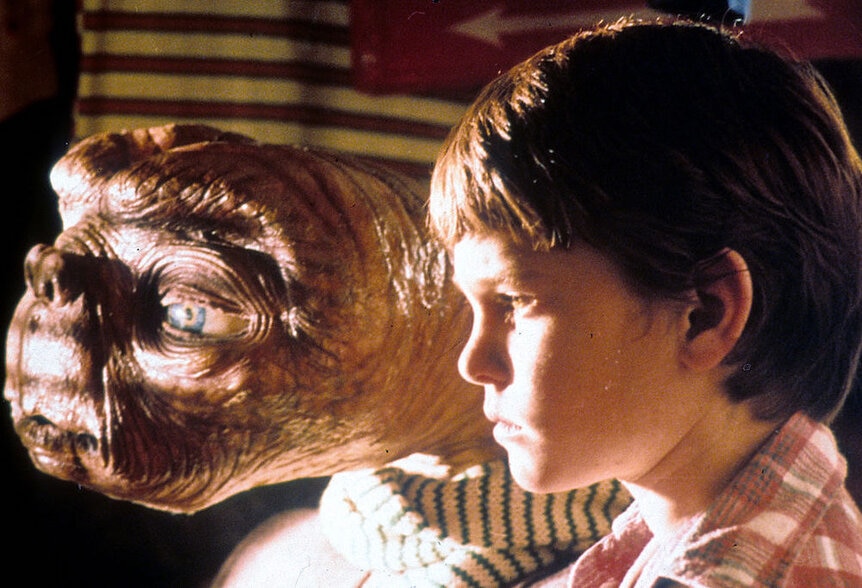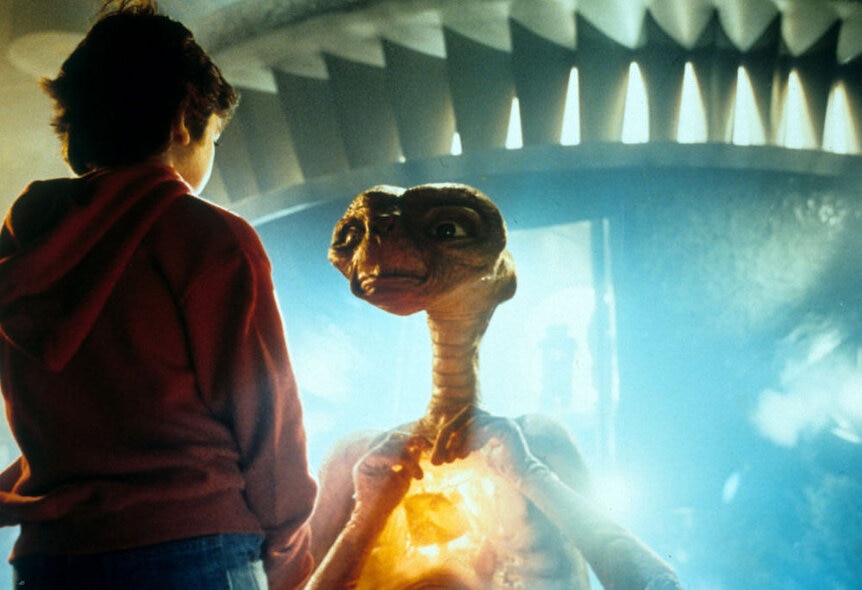Create a free profile to get unlimited access to exclusive videos, sweepstakes, and more!
How E.T. the Extra-Terrestrial Imagined a Kinder First Contact
We should be so lucky.
By the early 1980s, flying saucers and little green men had firmly cemented themselves in the public consciousness. Until that point, with a few exceptions, stories of malicious extraterrestrials chewing through humanity one city or one person at a time dominated theaters. Invasion of the Body Snatchers and Ridley Scott’s Alien hit theaters in ’78 and ’79, respectively, and both still have cultural cache today.
Among the few exceptions was Steven Spielberg’s own Close Encounters of the Third Kind (1977), in which peaceful aliens descend over Devil’s Tower, Wyoming, taking one man on a whirlwind adventure to the stars. A few years later, Spielberg revisited similar themes in an even more personal way in his science fiction classic E.T. the Extra-Terrestrial — now streaming on Peacock. Often, extraterrestrial stories lean into the unfamiliarity of alien life to bottle fear or anxiety, but E.T. pulled off a harder trick in a kind, loving first contact story, and in demonstrating that humanity isn’t limited to humans.
Steven Spielberg Imagines a Gentler Alien Invasion in E.T. the Extra-Terrestrial
At the time of release, E.T. broke the record for a theatrical run, spending more than a year on movie screens. In the meantime, it also became the highest grossing film ever made — earning $359 million during its original release on a modest $10.5 million budget — a position it would hold for more than a decade until Spielberg knocked himself out of the top spot with 1993’s Jurassic Park (also available on Peacock!).
RELATED: Steven Spielberg Reveals How a Memorable Father-Son Moment in Jaws Helped Inspire E.T.
The difference between E.T. and its peers is apparent right from the jump. We are introduced to the titular extraterrestrial not through an energy beam disintegrating a national monument or through a slimy egg and parasitic reproduction, but by way of a gentle midnight stroll through the woods. These aliens aren’t here to ravage our planet or bend us beneath their three-toed bootheels, they are here for plants. E.T. and his compatriots are botanists, scientists, gardeners, the hobbits of interstellar space, and they are here to sample the vast array of verdant green covering our lush planet.
Inside the ship — almost Victorian in design, like an interstellar diving bell, it communicates a sort of retro-future aesthetic which is both enticing and calming at once — things are a little weirder, as you might expect, but still wholly peaceful. There are plants, both earthly and alien, pilfered from a collection of visited worlds, covering every spare inch. Our brief view of their interior living space has the vague feel of an intergalactic headshop in flight, the sort of place that might be designed by The Dark Crystal’s urRu (Mystics) if they traded in magic for gadgets.
Distracted by the collection of a small evergreen tree, E.T. doesn’t notice when the rest of his troop lift their heads in surprise and worry like a slow-moving herd of meerkats. He’s lost in wonder at the serene city stretching out before him, electric lights tinkling like so many low-flying stars, when headlights cut through the dark. Tires crunch gravel. And men wielding flashlights tromp through the forest in search of squat little aliens. Cut off from the group, E.T. makes a run for it and the men give chase, their flashlights cutting like machetes through the woods, but it’s too late. E.T. is left behind.
The Origin of E.T. the Extra-Terrestrial
Following the success of Close Encounters, Spielberg began work on a sequel, a much darker movie about a family terrorized by malicious aliens on a remote farm. That movie, originally titled Watch the Skies and later Night Skies, was never made, but parts of it made their way into E.T. while other parts became the movie Poltergeist.
Spielberg was working on Raiders of the Lost Ark at the time with Harrison Ford and Ford’s then-girlfriend Melissa Mathison. He was thinking a lot, and talking with Ford and Mathison, about two seemingly disparate ideas. The first was his parents’ divorce when he was 18 years old, and the second was the question of what might have happened, had one of the aliens from Close Encounters been left behind at the end. Over the next few months, Spielberg and Mathison churned out a script, borrowing a few ideas from Night Skies, that would eventually become E.T.
Cut to a suburban home, kids sitting around the kitchen table playing a game, ambient cigarette smoke fills the air. It was 1982 and divorce in the United States was at an all-time high. Elliott (Henry Thomas) is sent to pick up a pizza, ordered clandestinely while the resident mom, Mary (Dee Wallace) was out of the room. On his way back inside, pizza in tow, Elliott hears a noise which he thinks belongs to the family dog. He finds E.T. instead.
RELATED: The Shared Story Roots of 'E.T The Extra-Terrestrial' and 'Poltergeist'
The inside of Elliott’s home, nestled comfortably in the heart of suburbia, should mirror the sort of welcoming and familiar environment inside E.T.’s mothership. It’s an environment designed to be so safe and comfortable that even the dog has his own twin-sized bed, complete with framed portrait on the nightstand. But, just like E.T.’s mothership, Elliott’s home has been upset by the sudden disappearance of one of their number. His father, it seems, has abandoned ship and left for Mexico with his new girlfriend, Sally.
We can only imagine the pain experienced by E.T.’s family at the realization that he’s missing, left behind on an alien world. But the pain cracking through Elliott’s family is all too apparent. Frustrated that no one believes him about his initial alien encounter, Elliott says something intentionally hurtful to his mother. The older brother, Michael (Robert McNaughton), reacts the way older brothers do, threatening to kill Elliott at the first opportunity. Later, he dials it back, but remains clear that their mother’s feelings matter. Whether the players are human or alien, empathy is a theme throughout.
When Elliott and E.T. first come face to face, after the screaming is finished, they begin by mirroring one another’s actions. It serves as a way of communicating to the characters and to the viewer that even though these two creatures couldn’t be more biologically different, they are also strikingly the same. That figurative connection becomes literal when the pair begin sharing one another’s emotions. We first see it when E.T. opens an umbrella, frightening himself, and Elliott becomes startled in another room. Later, Elliott gets drunk in class because E.T. is slamming Coors back at home. Even when it’s silly, it’s about connection, understanding.
E.T. Is Separation Anxiety Brought to Life
This movie might not have worked if not for the incredible performance of a young Henry Thomas as Elliott. You’ve likely seen his screen test circling the web, but it’s worthy of a revisit. You’ll really believe there’s an alien in the room with him and they are the very best of friends. Roger Ebert called it, “what has to be the best little boy performance I’ve ever seen in an American film.”
Somehow, Thomas captures the feelings of betrayal, fear, loneliness, and confusion which occur when a parent leaves. Those feelings of E.T. stranded on an unfamiliar planet mirror the emotions of a child unmoored. Spielberg toyed with a similar concept in Close Encounters, following a father who becomes increasingly obsessed with alien visitation to the detriment of his familial relationships. In the end, Neary (Richard Dreyfuss) climbs an extraterrestrial ramp and abandons his family altogether to go frolicking with aliens.
E.T. isn’t a direct sequel to Close Encounters, but it does center on a family which looks an awful lot like the one Neary left behind. Spielberg has said that even later in life, all of his films deal with his parents’ divorce in one way or another. This movie might just be the most direct. “A divorce creates great responsibility, especially if you have siblings; we all take care of each other. What if Elliott, or the kid – I hadn’t dreamt up his name yet – needed to, for the first time in his life, become responsible for a life form to fill the gap in his heart?” Spielberg said in front of a crowd at the Turner Classic Movies Film Festival in 2022.
First Contact Through the Eyes of a Child
E.T. the Extra-Terrestrial works so well because it is seen through the limited but wholly open perspective of a child. It plays out not on the white house lawn or inside of a sterile government lab but in your own backyard, in your own childhood bedroom. The film is shot largely from the waist down, we almost never see an adult’s face unobscured. This is a story about kids, from the perspective of kids. They don’t have all of the skills of adults, but neither do they have the baggage.
Because they are children, they aren’t aware of the machinations of adults or the government protocols swinging into place in the background. Elliott and his siblings are more concerned with their new friend and helping him to find his way home. Because what Elliott learns by the end is that sometimes people are only meant to be in your life for a season, even people you love very much. Like the army of frogs frantically released during the mid-movie dissection scene, Elliott knows that the only way to keep E.T. safe is to let him go. Elliott wasn’t only a good ambassador for humanity’s first contact with another intelligent species, he was the best.
RELATED: Yes, E.T. Is a Plant: Spielberg Reveals Secrets in Exclusive Excerpt from New Book on Early Career
He meets E.T. — the most alien thing he will ever encounter — with openness, a lack of prejudice, empathy, and a willingness to open his heart even in the face of tremendous loss. The connection between Elliott and E.T. may be reinforced by psychic alien magic, but it only exists at all because Elliott extended his humanity and found it, likewise, in E.T.
There are half a million things that separate Elliott from E.T., they have no shared language, no shared cultural context or experience (save for a few days shared together) and they look like nothing the other had ever seen. They might have found any excuse to distrust one another, but instead they found common ground in their mutual emotions and built a relationship that helped both of them, figuratively or literally, find their way home. Perhaps Agent Keys (Peter Coyote) said it best: “His being here is a miracle. It’s a miracle, and you did the best that anybody could do. I’m glad he met you first.”
Revisit the best first contact scenario imaginable in E.T. the Extra-Terrestrial, streaming now on Peacock.

































